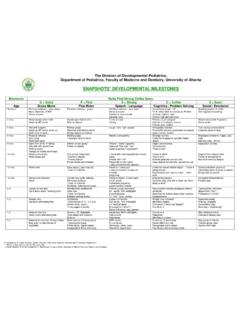Transcription of Ruiz-Casares.Radic.2015.Infosheet144E ABedit IR MRCf AB
1 Page 1 of 9 Information Sheet 144E Legal Age for Leaving Children Unsupervised Across Canada M nica ruiz -Casares & Ivana Radic March, 2015 This study reviewed Canadian (a) statutory norms and jurisprudence to determine age at which children can be left unsupervised and (b) safety, child self-care and babysitting programs. Only three provinces establish a minimum age (12 or 16 years) at which children can be left alone or in charge of other children. Quebec is the only province with an age limit for leaving children unsupervised in a vehicle (seven years). Age is only one of the child factors generally considered by the courts in assessing adequate care and supervision.
2 Canadian social services organizations advise that children under 12 years should not be left at home alone. Policy and advocacy efforts should provide accurate information and support to caregivers and children. Introduction Parents and caregivers often have to make difficult decisions to ensure children s safety and support while coordinating school-work schedules and facilitating children s growing independence. In reality, many children regularly spend time home alone unsupervised. As children mature, increasing autonomy may help them engender responsibility and self-reliance (Flynn & Rodman, 1989, p. 668). However, lack of supervision has been linked to a number of negative outcomes such as unintentional injuries and death in young children (Petrass, Blitvich, & Finch 2009; 2011; van Beelen et al.)
3 , 2013; Panzino et al., 2013) and self-harm in adolescents (Richardson et al., 1989; ruiz -Casares et al., 2012). For parents, the consequences of leaving children without adequate care or supervision may also include legal responsibility. Indeed, in the USA and in Canada, lack of supervision is the most common type of substantiated child neglect ( ruiz -Casares, Trocm , & Fallon 2012; Hussey, Chang, & Kotch, 2006). Child welfare jurisdictions across the 13 Canadian provinces and territories define supervisory neglect in terms of caregiver behaviors that result in harm or place children at risk of harm ( , no observable harm needed to bring legal charges against caregivers) ( ruiz -Casares, Trocm , & Fallon, 2012).
4 Inadequate parental supervision may encompass behaviors and circumstances that include not watching a child closely enough, using inadequate substitute child care, failing to protect a child from a third party, or allowing a child to engage in a harmful activity (Coohey, 2003; 2008). In this study, we focus on the use of inadequate substitute childcare and particularly leaving a child alone or under the supervision of another child in a vehicle or at home. While other factors such as child s maturity and context are essential when determining adequate Page 2 of 9 Information Sheet 144E supervision (DePanfilis, 2006), clarifying legal minimum ages below which children shall be presumed not to have the capacity to care for themselves or other children would help guide caregivers and professionals.
5 Findings Legal age limits for leaving children alone at home or in a vehicle in Canada Parents are required to adequately provide for the supervision of their children at all times as they are ultimately responsible for their children s safety. As indicated in Table 1, the definition of child under welfare Acts is linked to the age of majority in seven provinces and territories. One territory defines child as a person under 18 where the age of majority is 19. The remaining five provinces and territories define child as either being or appearing to be under the age of 16. The majority of provinces and territories do not limit the age at which a child can be left alone in their statutory rules.
6 However, in two provinces (Manitoba and New Brunswick), the welfare Acts state that a parent cannot leave a child under the age of 12 unattended without making provision for adequate supervision. In Ontario, the statutory limit is 16 years. When it comes to leaving a child unattended in a vehicle, only Quebec establishes a statutory age limit (seven years). Jurisprudence specifically related to child age and lack of supervision is limited, even where there is a statutory age limit. Indeed, in provinces with a statutory age limit, sometimes the courts applied the statutory rule. For example, the Queen's Bench in Manitoba stated that because children between 19 months and 8 years were left alone, protection was needed1.
7 Other times age did not appear to be a determining factor. For example, an Ontario court concluded that, because the mother was living a party lifestyle , there was a serious risk of emotional harm to five year-old child and intervention was necessary2. Where the Statutes are silent as to the age at which a child can be left home alone, the courts have weighed in their position. Most noteworthy is an Alberta case where a father specifically asked if his 11 year old son could be left home alone for 3 hours after school; the court said that children under 12 should not be left unattended by parents during parenting hours3.
8 In Alberta, families appear to be expected to arrange care for children under 12 years (Government of Alberta, 2014). Additionally, in foster/kinship cases, government authorities define "a safe and stable environment for a child" to include ensuring the child under 12 is not left unsupervised (Alberta Human Services, 2012). In most cases, an analysis of lack of supervision of young children is included in a pattern of neglect that leads to a serious risk of negligence for children under 12 years of age4. However, age in itself is not the only or determining factor. In a Nova Scotia case, the court found that leaving a 13 year old child alone overnight in the home did not amount to adequate supervision of the child because that 13 year old was not mature and not responsible enough5; in another case in the same province, the court found that leaving children under five and two years of age unattended for short periods of time (here the mother would exit the home to smoke) was acceptable6.
9 Page 3 of 9 Information Sheet 144E Table 1: Legal Framework for Child Supervision at Home or in a Vehicle in Canada (2014) Province/ Territory Legal age of majority Child (Welfare Act) Child home alone (years) Child alone in vehicle (years) Situations Penalties Fine (CAD) Imprisonment (months) Alberta 18 18 Abandonment/loss 25,000 12 Inability/unwillingness to supervise British Columbia 19 19 Abandonment Inability/unwillingness to supervise No/inadequate care provision Manitoba 18 18 12 Inability/unwillingness to supervise 50,000 24 No/inadequate care provision New Brunswick 19 19 12 Abandonment/loss 240 10,200 3 only repeat offence Inability/unwillingness to supervise No/inadequate care provision Newfoundland and Labrador 19 16 Abandonment 10,000 6 No/inadequate care provision Northwest Territories 19 16 Abandonment 10.
10 000 12 Inability/unwillingness to supervise Nova Scotia 19 16 Abandonment Inability/unwillingness to supervise Permitting criminal behaviour Nunavut 19 16 Abandonment 10,000 12 Inability/unwillingness to supervise Ontario 18 18 16 No/inadequate care provision 1,000 12 Prince Edward Island 18 18 Abandonment 2,000 No/inadequate care provision Quebec 18 18 7 Abandonment 625 5,000 No/inadequate care provision Saskatchewan 18 16 Inability/unwillingness to supervise 25,000 24 Yukon 19 18 Abandonment Inability/unwillingness to supervise Sources: Child Welfare, Majority and Traffic Safety Acts of all provinces and territories (see Endnote 7) Page 4 of 9 Information Sheet 144E Unsupervised children in need of protection and legal consequences In situations related to lack of supervision, the law identifies several conditions for a child to become a child in need of protection (Table 1).








